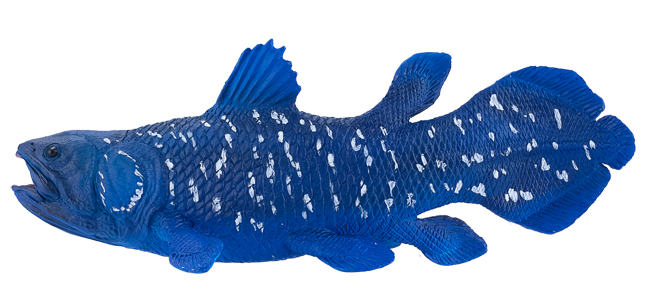Comparing the Brains of Extant Lungfish to their Ancient Relatives
The lungfish might be regarded by some as a “living fossil”, a term that we at Everything Dinosaur prefer not to use, as it implies that a species has remained present in the fossil record for a very long time.
However, the six species of lungfish alive today, do represent an extremely long lineage of fishes, that have remained relatively unaltered since they first evolved back in the Devonian. How similar extant lungfish are to their ancient counterparts has been determined by a team of researchers from South Australia (Flinders University) and Sweden (Uppsala University) who have used a combination of computerised tomography and computer modelling to map and compare the brains of living lungfish species with fossils dating back some 365 million years.
Ancient Vertebrates
Lungfish belong to the Class Sarcopterygii part of the huge bony fish group of vertebrates, that is most closely related to tetrapods and that includes our own species H. sapiens. Today’s lungfish, all six species, are becoming increasingly rare and scientists still do not know a great deal about them, their behaviours and how they are able to survive in extreme environments. One thing we do know, is that for a fish, they are relatively big brained.
Of course, brain size does not necessarily reflect cognitive function, but lungfish brains tend to occupy about 80 percent of their cranial cavity. Compare this to the somewhat more sedentary and a close relative of lungfish, the Coelacanth (Latimeria). Studies of Latimeria have shown that less than 5% of their cranial cavity is occupied by their brains.
A Replica of a Coelacanth
The image (above) shows a Mojo Fun Coelacanth model.
To view the Mojo Fun model range: Mojo Fun Prehistoric and Extinct Models and Replicas.
Using Technology to “Brain-warp” Lungfish Fossils
Having a cranial cavity which is mostly filled by brain tissue is a trait more associated with mammals than with fish. Knowing this, scientists can use the endocast of lungfish fossils that have been preserved in three-dimensions to map the brains of these ancient creatures. That is exactly what the Swedish and Australian researchers did and their paper has been published on-line in the open source directory of the Royal Society.
The fossilised remains of a Late Devonian lungfish (Rhinodipterus) excavated from the Gogo Formation of western Australia have been subjected to high resolution computerised tomography and the data has been used to “brain-warp” cranial soft tissues so the brains of long extinct creatures can be constructed.
A Three-dimensional Skull Fossil of the Sarcopterygian Rhinodipterus from the Gogo Formation
Picture credit: ABC
The picture above shows a right lateral view of the skull of Rhinodipterus excavated from the famous Gogo Formation . The three-dimensional preservation of fossils has permitted the cranial research to take place.
Biologists Study Lungfish
Flinders University evolutionary biologist and lead author of the scientific paper, Alice Clement commented:
“These fishy cousins of ours offer a great insight into our ancient ancestors who first crawled out of water and onto land some 370 million years ago.”
The research team used the endocast from a fossil lungfish to form a three-dimensional diagram of the brain and surrounding tissue. From this, the scientists could develop ideas regarding brain function and phylogeny of the lungfish family as a whole. An ancient lungfish brain reconstructed in virtual reality is one thing, built in conjunction with the team’s own sophisticated and novel distance mapping software, but it is hoped these techniques can be applied elsewhere in the fossil record.
Mapping the Brains of Lungfish
Picture credit: The Royal Society
The picture above shows brain comparisons between an extant Queensland lungfish (Neoceratodus) and the extinct lungfish Rhinodipterus of the Late Devonian. Colour coded distance map (a) for the relationship between brain and cranial cavity in Neoceratodus, (b) a three-dimensional endocast of Rhinodipterus. The reconstructed brain of Rhinodipterus (c) presented as a colour coded brain endocast distance map and (d), a spatial overlap of the reconstructed Rhinodipterus brain (grey) with the endocast (pale red). The reconstructed brain of Rhinodipterus viewed from the top (dorsal view) is diagram (e).
Brains are Difficult Things to Study
The new “brain-warp” method is important because when it comes to ancient anatomy, brains are extremely difficult to study. Soft tissue such as brains is highly unlikely to fossilise, although brain shape and structure can be inferred if the bones that surround the brain are preserved. By examining the hollow, a lot of information about brain morphology can be obtained.
Palaeontologist John Long, an expert on the fossils of the Gogo Formation and co-author of the scientific paper commented:
“Animals’ soft tissue usually breaks down, so discovery of a fossilised brain is very rare.”
The Strategic Professor of Palaeontology at Flinders University went onto explain that lungfishes have a very long evolutionary history, first evolving some 410 million years ago and having a peak diversity of about a hundred species during the latter part of the Silurian and through to the Devonian.
Weird Facts about Lungfishes
- Molecular studies using living lungfishes and the Latimeria genus of Coelacanth have shown that lungfishes are more closely related to tetrapods than Coelacanths.
- Six species of lungfish are known, the Queensland lungfish (Neoceratodus forsteri) from Australia, four species from Africa and one species from South America.
- The South American lungfish (Lepidosiren paradoxa) when first scientifically studied in the mid 1830s was thought to be a reptile due to its close affinity with tetrapods.
- The West African lungfish (Protopterus annectans) can go without food for more than three years. When this lungfish was scientifically described by Sir Richard Owen, it was placed at first with the Class Amphibia (amphibians).
Visit Everything Dinosaur’s award-winning website: Everything Dinosaur.









Leave A Comment